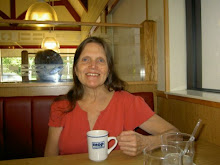Today's matinée (Sunday, Oct. 26th) was a present to myself on the occasion of one of children's birthdays (the 4th to turn 28, egad!) and what a wonderful gift it was. I don't think I've been inside the City Center theater since NYCB called it home prior to moving to Lincoln Center. My mother, and at Nutcracker time my father too, took me there back then and I remember it being BIG. Well, either it shrunk or I grew up. I think we know which. Entering the orchestra section flabbergasted me -- it was such a little place!
I was led to my front row seat (a perfect one, no.105) and seated, had the stage almost in my lap. I don't think I ever sat in the front row with my folks when I was little. The orchestra pit is quite small and deep, so the lip of the stage puts you intimately in touch with the action on it.
I was so eager to see "The Leaves are Fading" for it was to be the second time I'd seen a company dance it this year. In February I watched all performances of Festival Ballet Providence's production of it because my daughter was a member of the company.
 |
Järvi Raudsepp and Roger Fonnegra in Festival Ballet's The Leaves are Fading, February, 2008 Gene Schiavone photo |
Jared Matthews also had a loose, joyful jump as he partnered Maria Ricetto in one of the duets. Both danced with enchantment and pleasure and conveyed it to us in the audience very easily. A lovely pas de deux. After being so charmed by Tobin Eason last Friday at Bard, I noticed him as soon as he danced onstage today. He had a similar jovial face, a little toned down to befit "Leaves", and my glance gravitated toward him again and again.The partnership of Veronika Part and Alexandre Hammoudi worked very well in this ballet. Their pas de deux was golden. I especially loved the weighted way Veronika lifted her leg in grand battement, achieving a solid position at the top of the movement and holding it. She was secure throughout and, yes, I will add, perfect. An absolute standout in "Leaves". Hammoudi was a skilled partner with an accomplished performance himself, and they suited each other fully.
 |
Marcelo Gomes and Julie Kent in The Leaves are Fading Gene Schiavone photo |
Marcelo, king of sensual dancing, yearned for his ladylove, playfully drew her into his circle of allure -- even his eyes alone flirted with her -- and then he rejected her, as is meant to happen. Julie was sheer perfection but for a botched turn sequence which forced her down to flat, but this was probably only noticed by the ballet-savvy. In Providence (where McKerrow and Gardner spent weeks teaching the ballet), Mark Harootian danced Marcelo's role extraordinarily well. I liked parts of Mark's interpretation even better than I liked Marcelo's. To be able to compare is interesting. I loved the way Marcelo danced it and I loved the way Mark danced it. Who's next?
The success of the ballet lies in Tudor's choreography. The close-fisted men's steps danced to a staccato beat, for instance, lend a certain clever power to the gender which may be reminiscent of a time period (as this ballet deals with the passage of time) where "men were men and girls were girls". It's an appealing and eye-catching movement. The overhead lifts, with the women held on straight arms just above the back of the waist, draping languidly backwards over the men's heads, have such a pleasing appearance that Tudor must have used them as often as he did just for the aesthetic effect. Same goes for the lifts where the female's front and back legs are simultaneously bent at the knee from a 180° split position while being held aloft over the man's shoulder while both gaze lovingly into each other's eyes. Looks so pretty.
When the stage fills with all 15 dancers, it's a splendid flurry of strikingly simple, flowing pastel costumes, expansive, elated movement and longing glances which draw the ballet to a close with the reappearance of the one having the memories. We who watch are filled with longing, too, for we crave more of such loveliness.
A word about the conductor, Charles Baker. Never since Leonard Bernstein have I seen an orchestra leader so involved with the music he's conducting. My seat was to the left of him by three seats and during the overture he was as wonderful to watch as the dancers who followed. During the ballet, he sometimes vocalized quietly along with the musical strains as he gave himself a workout, especially upper-body, in his effort to elicit the beauty of Dvoràk's score. Tudor and Dvoràk together anointed his face with a magical, angelic expression.
Next installment(s): Baker's Dozen and Citizen (I liked it!)













No comments:
Post a Comment